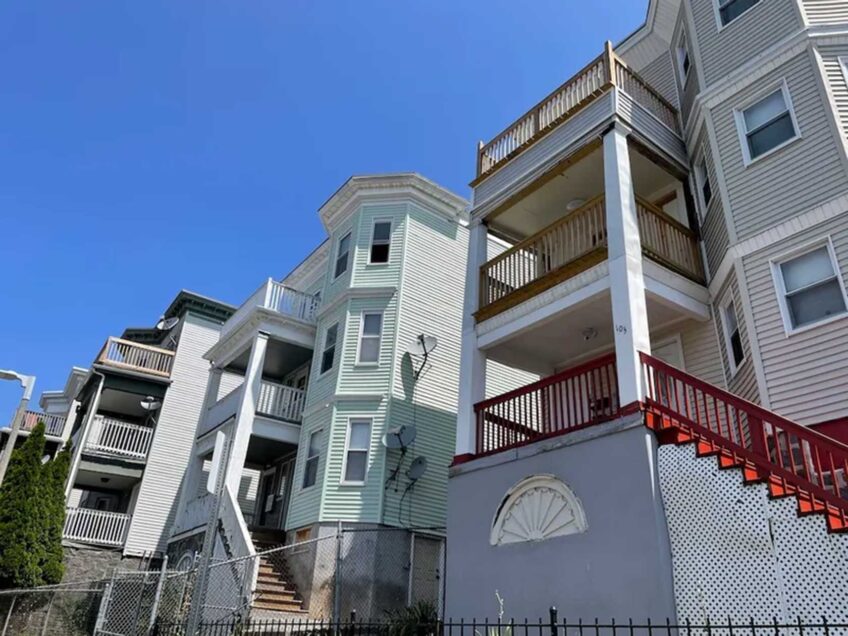
On Dec. 4, Bridgette Wallace walked through the Victorian home at 43 Hutchings St. She made note of the various interior features that will remain unchanged when the property is transformed into a “state-of-the-art tech center” for 14 young Black, brown, and Indigenous women and non-binary people of color.
“We’re trying to keep as much history of the property,” Wallace said during the ribbon-cutting event, pointing to quirks like the home’s decades-old laundry chute and hidden storage lockers.
In the coming months and years, the house will undergo renovations to its interior and the carriage house out in its yard, following approval from the Zoning Board of Appeal in July.
“It’s somewhat surreal because we’ve been working towards this end for quite some time, so I’m elated, excited, nervous,” said Wallace, founder of tech nonprofit G{Code} and owner of the Hutchings Street house, in an interview. “Because this is a new phase and a new step towards really actualizing this vision … [it’s] for us to really start the work on the ground in the community of Roxbury.”

The Victorian home at 43 Hutchings St. will be the site of G{Code} House, a live-in tech program. PHOTO: EBEN DENTE
At the ribbon cutting two weeks ago, Wallace was joined by a handful of supporters and G{Code} affiliates. The house will be an extension of Wallace’s online tech program G{Code}, which provides web development and data analysis courses and has over 300 graduates, according to Wallace.
The 4,000-square-foot Roxbury property will house program participants and provide for their basic needs for up to two years as they prepare for careers in the tech industry, Wallace said. The students will live in the main house, with two people per bedroom, and the carriage house will serve as classroom and event space.
“The average shelf life of technical skills is five years, four years at best, right? And so with the ground rapidly moving under you … it seems like an insurmountable challenge,” said Lindsay Nuon, board chair for G{Code}, at the ribbon cutting. “But I think what G{Code} does is put a stake in the ground, both physically with this building and just the people who come through its doors and saying, ‘No. You can be this. Look at these women who are really making their dreams come to life in real-time.’”
However, the live-in program hasn’t been favored by all. In June, the prospective live-in program was at the center of a neighborhood controversy after abutters expressed concern over how it would impact their street.
The Bay State Banner previously reported that neighbors felt the project would bring unwelcome changes to Hutchings Street since obtaining the necessary permits required that the house be classified as transitional housing. Neighbors installed signs in their yards decrying the zoning change, though Wallace and her team have emphasized that the program is not a “halfway house” or a “sober home.”
At the Zoning Board’s hearing in July, abutters reiterated their concerns, revealing tensions between Wallace and a group of Hutchings Street residents.
“The proposed zoning changes in the middle of our block would be detrimental to our community fabric and stability to support this would set a precedent for future developments to disrupt family neighborhood blocks like ours,” said Mayowa “MO” Osinubi, a longtime Hutchings Street resident, during the meeting.
Marilyn Chase, who has lived in the neighborhood for over four decades, said she was “concerned that our community is once again … being asked to sacrifice the stability of our street for the greater good of select individuals.”
Chase declined to comment on the Zoning Board’s approval.
G{Code} leaders said they had received support from the Garrison Trotter Neighborhood Association, which earlier this year voted in favor of the $4.2 million project, as well as Boston City Councilor Tania Fernandes Anderson, and State Rep. Chynah Tyler.
“Ultimately the goal is to provide some much needed … workforce development, housing and educational space which we think will serve the neighborhood, the larger community hopefully for generations,” said Andrew Baldizon, a real estate attorney with firm Goulston & Storrs, on behalf of G{Code}.
Asha Janay, a representative from the Mayor’s Office of Neighborhood Services, said while Wallace had undergone the necessary community process, the department received correspondence resisting G{Code} House, including a 67-signature petition, 13 letters from abutters, and verbal opposition from State Rep. Christopher Worrell.
In the end, the Zoning Board voted 5 to 2 to approve construction permits for the project. Members David Aiken, Hansy Better Barraza, Jeanne Pinado, Norm Stembridge, and Giovanny Valencia voted yes, while David Collins and the board’s chair, Sherry Dong, voted no.
Wallace said she has not personally heard from opposing neighbors since the board granted its approval and any opposition now would be “futile” because “the opportunity for them to have appealed the decision has now passed.”
She added that she is open to engaging with neighbors throughout the process and G{Code}’s marketing team would correspond with community members and keep them abreast once construction begins.
G{Code} has applied for its permits, and construction on the carriage house is slated to begin by the end of the month or, at the latest, in early 2025. The entire project is set to be completed in two years, Wallace said.
“My hope is that it will strengthen the identity of [Hutchings] Street, it will strengthen the neighborhood,” she said, “because we are bringing in young people, young women, who are serious about seizing opportunities that are before them.”






